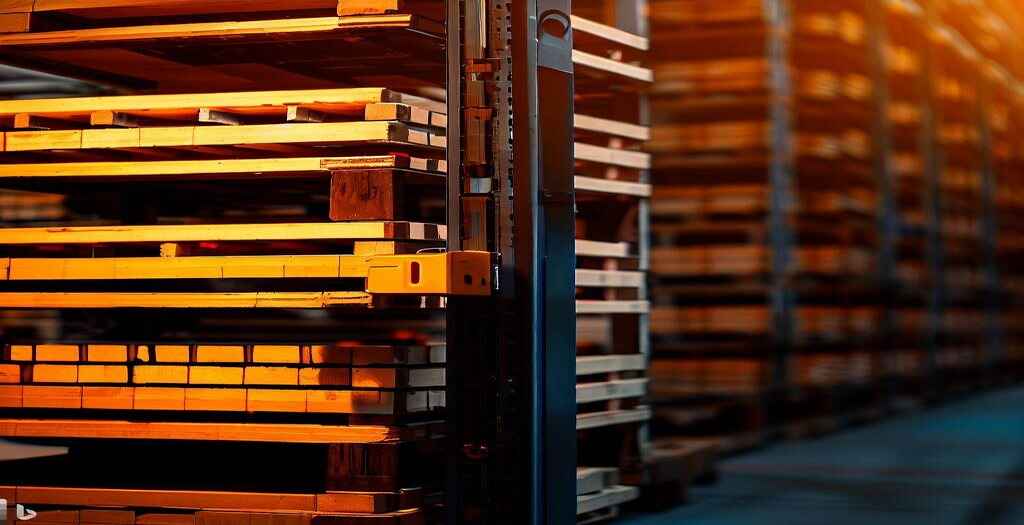
10 Things To Consider When Designing Warehouse Racking Layout
October 27, 2023
How To Avoid An Overflowing Warehouse?
November 23, 2023Pallets are all around us, even if we don’t always notice them. They are the unsung heroes of the material handling world, serving a wide range of purposes, from streamlining massive warehouse operations to being the canvas for creative DIY projects. Have you ever wondered about the variety of pallet types and their unique applications? If yes, then this blog is the perfect guide for understanding pallets, their types, and their various uses.
Understanding The Basics Of Pallets And Pallet Types
If you’ve ever marveled at the efficiency of a warehouse, pondered the sustainability of product packaging, or contemplated the creative possibilities of upcycling, let us tell you that the credit for this goes to the small and unnoticeable pallets. So, here’s a question. What exactly is a pallet and pallet types?
What Is A Pallet?
Pallets, often referred to as skids, are flat structures designed to support goods during transportation, storage, and handling. They serve as a sturdy foundation for a variety of products, from industrial materials to consumer goods. Pallets are an essential component of modern logistics. Different pallets are used across the globe in industries such as manufacturing, warehousing, transportation, and retail.
Pallets typically have a flat top surface with both top and bottom deck boards and are constructed to accommodate the entry of forklifts, pallet jacks, or conveyor systems. They come in various sizes and materials, allowing for flexibility in their applications.
Pallet Material And Its Importance
The pallet material in its construction plays a pivotal role in determining a pallet’s performance, durability, and suitability for specific applications. Various pallet types are made from a variety of materials, each with its own set of pros and cons.
Common materials for pallet construction include wood, plastic, metal, and paper. Each material offers distinct properties that cater to specific needs, making it essential for users to select the right material for their intended application. The choice of material can impact a pallet’s weight capacity, resistance to environmental factors, and overall lifespan.
Pallets are a fundamental and indispensable tool for multiple reasons. For instance, they are designed to standard dimensions and can be easily moved using forklifts, pallet jacks, and conveyor systems. This allows for quick and efficient loading and unloading of goods, reducing manual labor and the risk of injury.
They provide a stable platform that helps protect products during transportation and storage. By keeping goods off the ground and evenly distributing weight, they minimize the risk of damage, contamination, and moisture exposure. This is crucial for industries where the quality and integrity of products are paramount.
Moreover, pallets aren’t limited to industrial use alone. They have found innovative applications in DIY projects, gardening, and artistic endeavors. Repurposing and upcycling pallets is an environmentally friendly way to extend their lifespan.
Now that we know the importance of pallets, let’s talk about their types and uses.
Types Of Different Pallets
By Material
Paper Pallets
Paper pallets are typically constructed from paperboard or corrugated fiberboard materials. They are lightweight and environmentally friendly, as they are easily recyclable and biodegradable.
Being lightweight, these pallet types reduce transportation costs since most methods of transporting goods charge by weight. Moreover, less weight means they are easier to handle and carry.
Uses:
- Paper pallets are often used in the pharmaceutical and food industries, where cleanliness and hygiene are crucial.
- They are ideal for airfreight due to their low weight.
- They are commonly used for export shipments to countries with stringent wood treatment regulations.
Plastic Pallets
Plastic pallets are made from various types of plastics, such as HDPE (High-Density Polyethylene) and PP (Polypropylene). These materials make pallets durable and extremely resistant to moisture, which reduces the need for frequent replacement. Another advantage of plastic storage pallets is that they are easily cleaned and sanitized, maintaining high hygiene standards.
Uses:
- They are suitable for use in closed-loop systems, where pallets are returned for reuse.
- Plastic pallets are commonly used in industries where hygiene and cleanliness are critical, such as health, pharmaceuticals, and food.
- They excel in supply chains involving harsh environments, like chemical manufacturing and outdoor storage.
Wooden Pallets
Wooden pallets are constructed from various types of wood, with pine and oak being common choices. They are sturdy and widely used. They have a high weight-bearing capacity, which is suitable for heavy and oversized loads. Despite their excessive demand and a long list of advantages, they are cost-effective and readily available, making them a popular choice in many applications.
Uses:
- Wooden pallets are versatile and find applications in almost every industry, including manufacturing, retail, and agriculture.
- Often used for transporting heavy loads due to their strength and durability.
- They are popular for DIY and upcycling projects, given their availability and ease of modification.
Metal Pallets
Metal pallets are made from steel or aluminum. They are exceptionally robust and durable.
Uses:
- They are commonly found in heavy-duty industries, such as automotive manufacturing and steel processing.
- They are ideal for extreme conditions, including outdoor storage, and are resistant to fire and pests.
- They are used for long-term storage of goods due to their longevity and strength.
By Dimensions
Standard Dimensions
The most common standard pallet dimensions are 48 inches (width) x 40 inches (length). These dimensions are widely recognized and used across industries. These pallet types are highly compatible with a variety of handling equipment, including forklifts and pallet jacks, making them a better choice for almost every use and one of the best pallets for storage.
Uses:
- Versatile in nature and can be found in nearly every sector, from manufacturing and distribution to retail.
- They are commonly used for international shipping, as they can be efficiently loaded into standard cargo containers.
Half Pallets
Half pallets are smaller than standard pallets, typically measuring 48 inches (width) x 20 inches (length).
Uses:
- They are popular in retail settings, particularly for displaying and handling smaller or more delicate products.
- Also suitable for point-of-sale displays and can be used to improve in-store organization.
- In distribution centers, they can be employed for order picking and preparing smaller shipments.
Quarter Pallets
Quarter pallets are even smaller, measuring 24 inches (width) x 20 inches (length). They are extremely space-saving and easy to maneuver within crowded retail spaces.
Uses:
- Quarter pallets are primarily used in retail for displaying small items, samples, or seasonal products.
- These pallets are often chosen for special promotions or limited-time offers.
Euro Pallets
Euro pallets adhere to the European standard dimensions, measuring 1200 mm (width) x 800 mm (length).
Uses:
- Euro pallets are used for a variety of applications, including transportation, warehousing, and retail.
- They are widely recognized for their compatibility with Euro containers, optimizing supply chain efficiency.
By Design
Stringer Pallets
Stringer pallets are one of the sturdiest pallet types. They have two or three parallel longitudinal beams, or stringers, running the length of the pallet, with deck boards perpendicular to the stringers.
Uses:
- Stringer pallets are used for storing and transporting heavy loads, as the stringer design provides exceptional support.
- They are often preferred for industrial applications and the transportation of bulky or oversized items.
Two-way Entry Pallets
As the name indicates, two-way entry pallets allow forklift or pallet jack entry from two opposite sides, typically the longer sides of the pallet. They are ideal for bulk storage and organized stacking.
Specialty Pallets
Heat-treated Pallets
Heat-treated pallets are treated through a process known as heat treatment (HT) to eliminate pests, fungi, and pathogens. The treatment involves heating the pallet to a specific temperature for a set duration, which conforms to international phytosanitary measures. They are typically marked with an “HT” stamp.
Uses:
- HT pallets are primarily used for international shipping and transportation, as they comply with ISPM 15 regulations (International Standards for Phytosanitary Measures).
- They are commonly employed in industries where compliance with phytosanitary standards is crucial, such as agriculture and food production.
Final Thoughts
Whether you’re in the business of moving products or simply looking for your next DIY project, pallets offer endless possibilities. Remember that selecting the right pallet, be it by material, dimensions, or design, can make all the difference in streamlining your operations, enhancing your displays, or supporting your imaginative endeavors. To increase efficiency in your business and warehouse, it is extremely important to choose the best pallet types. And for that, Midwest Distribution LLC is here. We can provide you with pallets that will make your business much more efficient!

